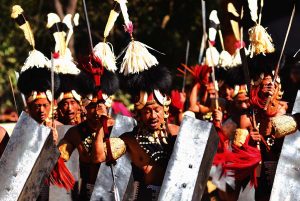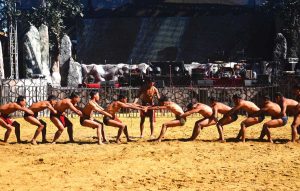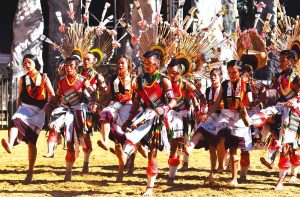Nagaland
Cultural troupes: The face of Hornbill Festival

They met as strangers. They leave as friends
Kohima, Dec. 10 (EMN): Dance performances and folk songs steeped in indigenous lore are some of the identities of the ethnic Naga people. The Hornbill Festival of Nagaland began with 17 cultural troupes from Nagaland entertaining visitors and spectators in Kisama village, in Kohima district. They continued till the last day of the festival on Dec. 10.
They continued to embellish the arena in their indigenous attires, and fighting the chilly weather yet proving an eyeful for the spectators especially for tourists from outside the state.
The final day of the festival saw 17 cultural troupes performing folk songs and dances from 10 am till 3 pm. The morning session saw nine cultural troupes comprising the Angami, Khiamniungan, Zeliang, Kachari, Yimchunger, Pochury, Sumi, Lotha, and Chang Naga tribes.
In the evening session, the Sangtam, Konyak, Phom, Kuki, Ao, Rengma, Chakhesang, and Garo communities performed to their best.
During the event, what caught the wonder of the spectators was the Uwhe (Chakhesang for ‘war cry’) portrayed by Chakhessang youngsters. They depicted training that young boys in their pre-puberty undergo in martial skills and warfare.

The performance saw young boys dressed in nothing more than their pre-puberty age, wrestling each other inside the main arena, which signified the end of training, and that they were trained and ready for war.
The cultural segment of the festival was named the ‘cultural connect.’ Indeed, as an official from the organising department, department of Art & Culture, says: “The troupes met as strangers. Now they leave as friends.”
The final cultural extravaganza of the festival had the minister for Higher & Technical Education Temjen Imna Along as the main guest.
Hornbill’s main challenge: Infrastructure and accommodation
The government of Nagaland started the Hornbill Festival in the year 2000. The festival starts from Dec. 1 and concludes on the 10th, at Kisama village, a symbolic area representing a village which is the main venue of the festival.
The main objective of the festival is to promote Naga culture in the form of performance arts that are themed on indigenous cultural practices; it showcases the Naga way of life of the olden days. The target of the festival is to promote their culture to the world. Every tribe can take part in the celebration.

Nagaland is known as a tribal state because of its tribal population.
Each tribe is distinct from one another and no two tribes are alike in their culture or way of celebrating festivals. Festivals are celebrated as pre harvest or post harvest festivals and most of the festivals in Nagaland revolve agricultural cycle. Interestingly, not even a month goes by in a year without festivals which means people’s affinity to its festivals is highly respected and regarded. Festivals are mostly celebrated by the Nagas to seek the blessings of deity for bountiful harvest on their crops or to thank the deity for giving bountiful crops after harvest.
The Tourism department is the nodal department for the Hornbill Festival although organising the event involves the participation and contribution of all other departments.
Speaking to media personnel at Kisama, the secretary for Tourism T Mhabemo Yanthan said that the main challenges being faced by the state’s government when organising such a big event was the lack of proper infrastructure and accommodation.
In order to increase the inflow of tourists, a calendar of events is required for which the department of Tourism has begun working on it, he said. He said events should not be held only during the Hornbill Festival but round the year from January to December to promote the tourism industry in the state.
The deputy director of Tourism, Veyielo Doulo interacted with media persons too. He said that as far as the Hornbill festival was concerned there was room for improvement in the area of basic amenities such as water supply, toilets; ramp facility for people with disability etc. He strongly emphasised on the importance and necessity of home stay during the festival to cater to guests and tourists coming to visit and experience the ways of the Naga people and their land. He said that the present carrying capacity was very limited. He added that VIPs visiting only at the last moment was also a problem for the organising departments.
“Organising such a mega event will always have criticism but we accept criticism as an advantage and a strength for us to improve in the coming years,” he remarked. The officer has appealed to guests and tourists to come again along with their friends to experience the vibrant culture of the Naga people and their tradition, even in the coming years too. (Inputs from DIPR)

